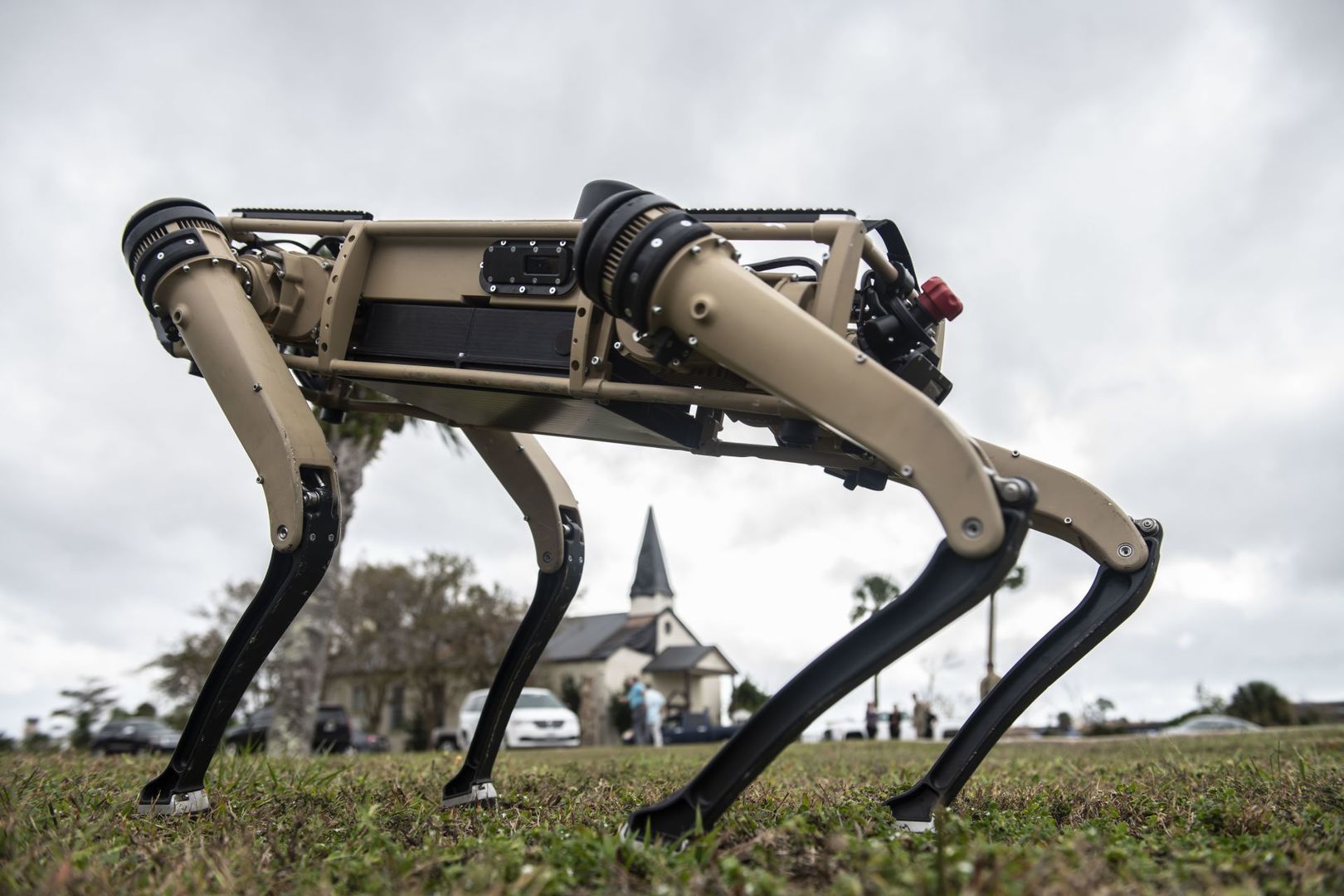| Robot dogs to enhance security at Tyndall AFB
机器狗加强廷德尔空军基地的安全 Date:2020-11-19 Source:Air Force News Agency By:Globalmil Viewed: |
by Air Force News Agency November 16, 2020
空军新闻社 2020年11月16日
An unmanned ground vehicle is tested at Tyndall Air Force Base, Florida, Nov. 10, 2020. Tyndall is one of the first military bases to implement the semi-autonomous UGV’s into their defense regiment, they will aid in reconnaissance and enhanced security patrolling operations across the base. (U.S. Air Force photo by Airman 1 st Class Tiffany Price)
2020年11月10日,佛罗里达州廷德尔空军基地,一台无人地面车辆正在进行测试。廷德尔是首批将半自主无人地面车辆引入其国卫团的军事基地之一,他们将在整个基地协助侦察和加强安全巡逻行动。(美国空军照片由一等飞行员蒂凡尼·普莱斯拍摄)
TYNDALL AIR FORCE BASE: Over the last year, Tyndall Air Force Base and the 325th Security Forces Squadron have been working with Ghost Robotics to develop a system to enhance security and safety for the base population.
廷德尔空军基地:去年,廷德尔空军基地和第325安全部队中队一直在与幽灵机器人公司(Ghost Robotics)合作,开发一个系统,以加强基地居民的安全保障。
Tyndall AFB will be one of the first Air Force bases to implement semi-autonomous robot dogs into their patrolling regiment. These computerized canines demonstrated their abilities Nov. 10 at an event attended by Maj. Gen. Tom Wilcox, Air Force Installation and Mission Support Center commander, and leadership from the 325th Fighter Wing and the Tyndall AFB Program Management Office.
廷德尔空军基地将是第一批将半自主机器狗引入巡逻团的空军基地之一。11月10日,美国空军装备和任务支持中心指挥官汤姆·威尔科克斯少将、第325战斗机联队和廷德尔空军基地项目管理办公室的领导出席了一次活动,展示了它们的能力。
“We are very excited,” said Maj. Jordan Criss, 325th Security Forces Squadron commander. “We are the first unit within the Department of Defense to use this technology for enhanced security patrolling operations.”
“我们非常兴奋,”第325安全部队中队指挥官乔丹·克里斯少校说。“我们是国防部内第一个使用这种技术加强安全巡逻行动的单位。”
While these robots walk on all fours and resemble a dog, they are not intended to replace the military working dogs. Instead, they will aid in patrolling operations and, in doing so, allow Tyndall AFB’s defenders to focus their efforts on security actions that require a physical presence.
虽然这些机器人四脚行走,看起来像狗,但它们并不打算取代军用工作犬。相反,他们将协助巡逻行动,并在这样做的时候,让廷德尔空军基地的保卫者把他们的精力集中在需要实际存在的安全行动上。
“These robot dogs will be used as a force multiplier for enhanced situational awareness by patrolling areas that aren’t desirable for human beings and vehicles.” Criss said.
克里斯说:“这些机器狗将作为一种力量倍增器,通过巡逻不适合人类和车辆的区域来增强态势感知能力。”
Criss explained that the robot dogs will be given a patrol path which will be set and monitored by the Security Forces Electronic Security Sensor System noncommissioned officer in charge.
克里斯解释说,机器人狗将被赋予一条巡逻路线,由安全部队电子安全传感器系统的非委任士官设置和监控。
“We will be able to drive them via a virtual-reality headset within our Base Defense Operations Center,” Criss said. “We will be able to see exactly what the robot dog is detecting through its mobile camera and sensor platform if desired, we will also be able to issue verbal commands to a person or people through a radio attached to the dogs.”
克里斯说:“我们将能够通过我们的基础防御运营中心内的虚拟现实耳机来驱动它们。” “如果需要,我们将能够通过其移动摄像头和传感器平台准确看到机器狗正在检测什么,我们还将能够通过连接到机器狗的无线电向一个或多个人发出口头命令。”
The semi-autonomous canines allow defenders that would otherwise be patrolling these areas to focus on training, security and overall situational awareness across the base.
这种半自主机器狗让原本在这些地区巡逻的守卫者能够集中精力在整个基地的训练、安全和整体态势感知上。
“These dogs will be an extra set of eyes and ears while computing large amounts of data at strategic locations throughout Tyndall Air Force Base,” Criss said. “They will be a huge enhancement for our defenders and allow flexibility in the posting and response of our personnel.”
克里斯说:“当在廷德尔空军基地的重要地点计算大量数据时,这些狗将成为额外的眼睛和耳朵。” “对于我们的保卫者来说,它们将是一个巨大的增强,并允许我们人员的岗位和响应方面具有灵活性。”
This technology has the potential to replace and exceed the capabilities of certain static defense equipment especially in a contingency, disaster, or deployed environment. This makes Tyndall AFB, post Hurricane Michael, the perfect home for the Air Force’s newest computerized canines.
该技术有可能取代并超过某些静态防御设备的功能,尤其是在突发事件,灾难或部署环境中。 这使廷德尔空军基地,迈克尔飓风之后,成为了空军最新的计算机化犬科动物的理想住所。
上一篇:Elbit Systems launches E-LynX-Sat – a portable tactical SATCOM system 下一篇:Pakistan conducts successful test flight of Fatah-1 GMLRS
| Here are the bunker-buster bombs used on Iran’s Fordo nuclear facility
这是用于伊朗福尔多核设施的碉堡炸弹 |
| In inserting itself into Israel’s war against Iran, the U.S. unleashed its massive “bunker-buster” bombs on Iran’s Fordo fuel enrichment plant.... [2025-07-05] |
| Ukraine's new F-16s receive secret US electronic warfare systems to counter Russi
乌克兰新获的F-16战斗机接收了美国的秘密电子战系统,以应对俄罗斯的威胁 |
| The electronic warfare systems on these Ukrainian F-16s were not part of the U.S. inventory, presenting a significant challenge for the 68th Electronic Warfare Squadron.... [2024-08-28] |
| No U.S. Navy Aircraft Carriers Deployed In The Pacific
美国海军没有在太平洋部署航母 |
| The U.S. Navy is facing a shortfall of deployed carriers in the Pacific as the buildup in the Middle East continues. ... [2024-08-27] |
| France and Serbia Successfully Conclude Negotiations for Sale of 12 Rafale Fighte
法国和塞尔维亚成功完成12架阵风战斗机的销售谈判 |
| Dassault Aviation has successfully concluded negotiations for the sale of 12 Rafale fighter jets to Serbia, marking a significant advancement in bilateral relations between France and Serbia, as reported by LaTribune.... [2024-08-27] |

